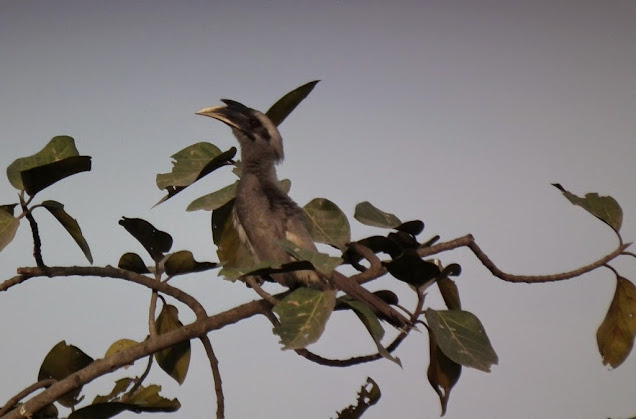The Indian grey hornbill is a large, arboreal bird and is
quite common all over the country. It has dark grey plumage, with upper part of
the body of a slightly darker shade and whitish belly parts.
It has a large curved beak with clearly discernible dark-red
colored eyes. In overall appearance, it can be mistaken for the Malabar grey
hornbill (see post Malabar Grey Hornbill).
Both species are similar in size and appearance, food habits and their
inclination for dwelling in tall trees. The Indian grey however is mainly found
on the plains, while the Malabar grey is a native of the Western Ghats. The key
feature that distinguishes Indian grey hornbill from its namesake from the
ghats is a pointed outgrowth (casque) on its beak. Females have a slightly
smaller casque.
Hornbills mainly feed on fruits and berries, dexterously
moving through thick branches to get them with their large beaks. They also
prey on small insects like grass-hoppers and lizards.
How to spot them?
Hornbills are arboreal in nature and are partial to a
variety of tall fruit and berry bearing trees, such as banyan and peepul. They
move about in small groups and are rarely seen singly. Their presence in the
upper reaches of branches is revealed by the high pitched calls, kee-kee…, and
noisy movement through the branches.
The birds can be seen in parts of Kalwa and near the hills
surrounding Mumbra, although such sightings are becoming fewer and far between.
One can also spot these birds at SGNP, Yeoor hills, Karnala and parts of
Vikhroli.
Causes for decreased numbers
Increasing urbanization and loss of habitat in the form of
large trees, in which they nest, are the chief causes for decreased numbers in
recent years. It is upto the local and state authorities to aggressively pursue
urban afforestation programs and create large spaces for forests and wooded parks
to preserve the wildlife. Pressure on natural resources will continue unless
the human population stabilizes at sustainable levels. Until that happens, wildlife will persistently cede ground to our ever expanding numbers.
Till then, we must be more environment conscious in our
daily lives; save water, reduce plastics, reduce unnecessary retail consumption,
stop food wastage and do our best.
Let us all do our bit to save planet Earth.
The
greatest threat to our planet is the belief that someone else will save it.
Robert
Charles Swan, OBE, FRGS, the first person to walk to both Poles.




No comments:
Post a Comment
Thanks for reading.
I appreciate your feedback! Please leave a comment below and let me know how I can improve my blog